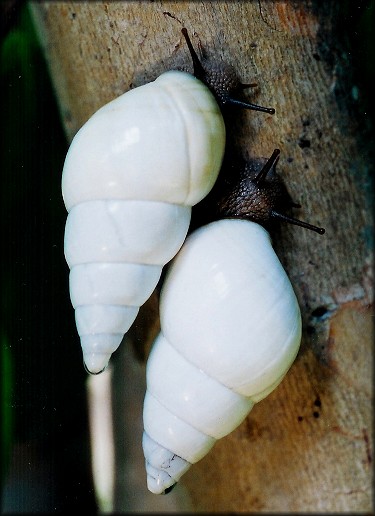|
Hammock Hopping And The Reward Of The Day |
||
|
It’s hot. It’s really hot. The rain shower that was passing through has just now passed, and the sun has returned with a vengeance. The high humidity isn’t allowing evaporation, and I am soaked with perspiration. The trees in the hardwood hammock stifle the lazy ocean breeze that normally caresses these parts of south Florida, and the mosquitoes have found me once again. The hot air is alive with the endless buzz of various insects, and the ineffective insect repellent in which I am covered is mixing with the sweat running down my face, burning my eyes. Paper wasps nesting under every other Sabal Palmetto threaten me regularly, and I have been stung once today already. I have to pause to brush away the tiny, biting ants every few moments, and I am covered with tiny scratches from the multitudes of unforgiving thorny vines and shrubs. I just heard the terrible and unmistakable buzz of a rattlesnake as it rustled away beneath the dense brush. I never saw it, but I won’t forget that noise for a long time. My camera is taking a beating of its own. Continuously taking it out of my backpack and then replacing it is way too tedious and time consuming (speed is everything when you’re shooting nature), so I have it slung over my neck. The camera body, a Nikon F4, is generally bullet proof (the sole reason I own it), but the auto-focusing lens is already protesting the grime as well as the showering it took earlier, threatening to warrant a costly replacement for the third time. My lens cap was knocked off and lost over an hour ago. I just fell down. I am overheated. I am tired. I am covered in spider webs and, most likely, the spiders. I have a rapidly advancing poisonwood rash on my left forearm. I am filthy. I am all alone. The internal voice that has guided me on so many past adventures is opting for sitting on the couch back home. You’re probably wondering what I’m doing here. I am wondering the same thing myself. But, alas, I am photographing nature, particularly snails, in the beautiful yet menacing splendor of the hardwood hammocks of Southern Florida.
Of particular interest to me today is the Florida Tree Snail, Liguus fasciatus (Müller, 1774). Considered a single species, this tree-dwelling pulmonate has some fifty-nine named color varieties, many of which can readily be observed in the hardwood hammocks of the Florida Keys and the Everglades. From fully albinistic to richly hued with every color of the rainbow, no two color varieties are completely alike. After the passing summer rain shower, the snails are actively out and about, feasting on the soot mold, fungi and lichen growing on smooth-barked trees, particularly the Wild Tamarind (Lysiloma latisiliqua) and the Jamaican Dogwood (Piscidia piscipula). The snails will feed and grow during the summer, then mate and lay eggs early in the fall, climbing down the tree to deposit their eggs under a couple inches of leaf litter. The Liguus will estivate (a snail’s answer to hibernation) during the dry winter months, attaching the aperture of the shell to a tree by means of a hardened mucus seal called an epiphragm. In the spring, the snails will come out of estivation, the eggs will hatch into tiny replicas of the parents, and the process will repeat itself.
These beautiful and delicate shells are extremely interesting to me, as are
the many stories told by “old time” collectors who studied, transplanted,
and collected Liguus more than a
decade before I was born. With
perhaps the exception of the Queen Conch [Lobatus gigas (Linnaeus,
1758)], there isn’t a single species of Florida mollusk that has fascinated
and captivated collectors more powerfully than Liguus fasciatus. Prior
to the late 1980's, thousands of Florida Liguus
were being taken annually by scores of collectors.
Ultimately,
due to a combination of collecting pressures and widespread development, the
species was named by the Florida Game and Fresh Water Fish Commission as a “Species
of Special Concern,” thereby outlawing collecting of either living or dead
specimens.
Under legal and conservation pressures, most snail enthusiasts now
brave the hammocks either to observe and study the snails or practice “collection
by photography," which is what brings me here. Archie Jones of Miami, the acknowledged authority on Florida Tree Snails, says that a person needs two traits to effectively study Liguus in their natural environment. The first is high endurance. The second is a low IQ.
My battered Nikon is at the ready. It’s tricky, though, because I can’t risk touching or repositioning the snails. If bothered, they will quickly retract into their shells for an unbearably long while, maybe not emerging before long after the heat and bugs force me to leave. It’s also a little tricky because the snails are in the deep shadows of the hammock. I don’t have a flash (it didn’t survive the downpour of last month’s outing, a day I like to call “Black Thursday”), so lighting, and consequently depth-of-field, are problematic. I pull from my bag of tricks (a.k.a. my spider web entombed backpack) a photographic reflector so as to angle sunlight directly on the snails. Still, I can only manage F 5.6 at 1/60th of a second, so extreme close up photography is limited due to poor depth-of-field (if the shell is in focus, the animal will be out of focus, and vice-versa). Additionally, the camera will tend to expose the picture based primarily on the bright white shells in the center of the viewfinder, causing the animal and the background to appear darkened in the resulting photograph. My solution is to shoot the shells from about 20 inches away (my lens is a 60 mm. macro), allowing as much light onto the subjects as possible with the reflector. Although the depth-of-field is still a problem, I try to minimize it by focusing on the area where the snail emerges from the shell. I then manually use +2 exposure compensation to lighten the background, and hope that the folks in my hometown film processing shop can do the rest. With high hopes and an increasing amount of insect repellent running into my eyes, the mosquitoes and I shoot three more rolls of film. I arrive at my car just as dusk arrives on the Hammock. Physically, I am a beaten man, but I am very content with the accomplishments of the day. I pull a tick off myself and hope that whatever else is on me won’t bite me while I’m driving, a potentially disastrous situation for all involved. I head towards a good, come-as-you–are, greasy spoon-type restaurant down the road where nobody looks twice at how bad you look. I get looked at twice anyway. Neither the spiders nor I much care. Comment: It should be noted that all color forms of Liguus faciatus are considered under the mantle of a Species of Special Concern in Florida, and it is illegal to collect either living or dead shells without a permit. Additionally, while many Southern Florida hammocks are accessible and open to the public, many natural hammocks of the Florida Keys (and other areas) forbid trespassing (some may be accessed by special permit). As indicated, the hardwood hammocks, especially in the Florida Keys, can be an unforgiving habitat. Be prepared. Be sure to know the laws that apply if you wish to partake in the observing and photography of these beautiful and interesting mollusks. |

